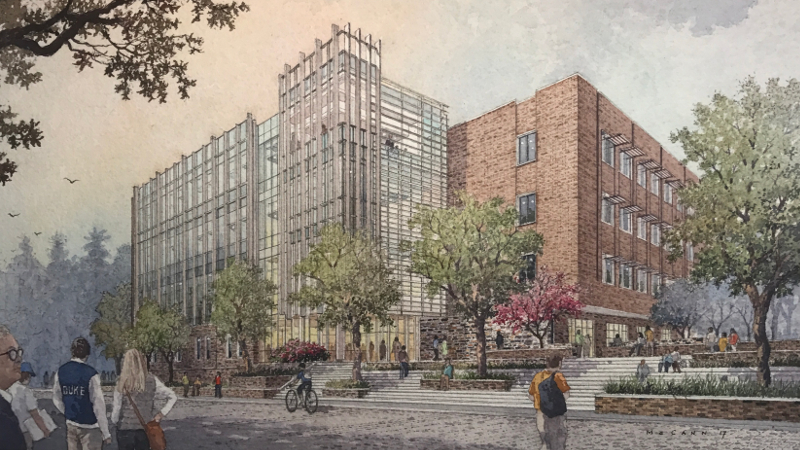Sustainability and Collaboration Under One Roof
By Jade Grimes
Scheduled to open for classes in 2021, Duke's new engineering building is already being used as a learning experience

It’s not uncommon to hear alumni reminisce of the time when there was no “E-quad,” when the area in front of Hudson was a mere parking lot, and when Science Drive connected to Research Drive. The Pratt School of Engineering’s newest building, the Fitzpatrick Center for Interdisciplinary Engineering, Medicine, and Applied Sciences, opened in 2004, transforming a parking lot behind the libraries into what students now know as the Harrington Engineering Quad. The Fitzpatrick Center doubled the building space for engineering students. Now, 15 years later, teaching space in Engineering is doubling once again to include a $115 million, 150,000-square-foot, five-floor addition.
As part of the recent Duke Engineering initiative to give students an educational experience that encourages firsthand experience with design, data science, computing, research and entrepreneurship, the new research spaces, or “neighborhoods,” will not be appropriated to individual departments, but rather overarching academic themes, like health innovation, computing and intelligent systems, and environmental health. Dean Ravi Bellamkonda stresses that he’s excited about the “quality of the space,” one that includes new labs (for design and research), offices, workstations, a learning commons, a new auditorium, open classrooms, and collaboration spaces. He also hinted at the possibility of a studio for videos and podcasts.
Designed to encourage active student learning, the open classrooms have their seating around large tables rather than rows of individual desks. Common areas, like the learning commons, a fourth-floor terrace and informal study spaces further promote collaboration.
 Dean Bellamkonda notes that the new building is at a great location. At the intersection of the medical school, Pratt, Trinity and the libraries, “It is the closest engineering will be to the main quad” and even “looks out to the Chapel from many conference rooms.” The critical placement reinforces the intent behind the research neighborhoods by allowing faculty and students from multiple Duke schools and disciplines to work together on improving the future.
Dean Bellamkonda notes that the new building is at a great location. At the intersection of the medical school, Pratt, Trinity and the libraries, “It is the closest engineering will be to the main quad” and even “looks out to the Chapel from many conference rooms.” The critical placement reinforces the intent behind the research neighborhoods by allowing faculty and students from multiple Duke schools and disciplines to work together on improving the future.
Mitchell Vann, Duke Engineering’s director of facilities, infrastructure and safety, emphasizes that while the building design promotes the creation of new technologies and innovations, the building itself makes use of new and sustainable technologies for water conservation, energy performance and resource management. It is expected to receive a LEED certification of at least silver.
By combining chilled water flow through beams as air conditioning, optimizing lab exhaust through experimental wind tunnel testing and employing other energy-conscious construction methods, the building has an “energy performance 30 percent beyond code requirements,” according to Vann. Over 20 percent of the building’s materials are from regional sources and over 20 percent are from recycled sources. A semipermeable continuous air barrier will reduce the building’s moisture intake while insulation, sun shading devices and a solar reflectance “cool roof ” will reduce heat intake.
The construction of the new building is also being used as a learning experience. Skanska USA is providing class and student group construction tours of the site until summer 2020. Even years before its opening, the building is offering students a real-world view on infrastructure, sustainability, systems and construction engineering. Undoubtedly, when it opens for classes in January 2021, the new engineering building will promote the upward trajectory of the Pratt School of Engineering, a school on the rise.
Jade Grimes is a sophomore pursuing a double major in civil engineering and environmental science with a certificate in architectural engineering.
